-
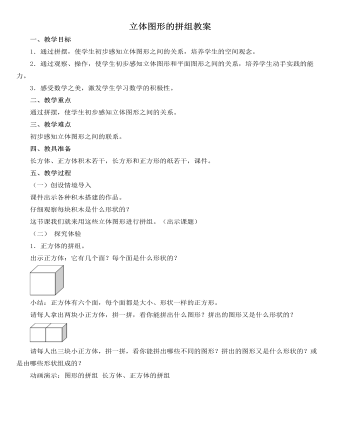
人教版新课标小学数学一年级下册立体图形的拼组教案
小结:分别沿正方形纸的两组对边做出的圆筒一样长、也一样粗,因为正方形的四条边都相等。解决问题。课件出示:你能用几种方法,数出下图中小正方体的个数?方法一:可以从上往下数(或从下往上数)第一层有2个,第二层有4个,第三层有6个,三层共有:2 + 4 + 6 = 12(个);方法二:也可以从左往右数(或从右往左数)。第一排有4个,第二排有6个,第三排有2个,三排共有:4 + 6 + 2 = 12(个);方法三:还可以将最上面一层的2个移到第二层的右侧。这样,这堆木块就变成了两层,每层都有6个,共有6 + 6 = 12(个)。(四)全课总结这节课我们用长方体和正方体拼组了很多不同形状的图形。其实在我们的生活中,有很多物体的形状都是由长方体和正方体拼组而成的,希望同学们课下留心观察。(五)练习数一数,下面的图形由几个正方体组成?
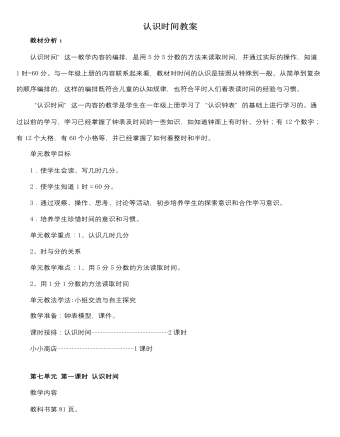
人教版新课标小学数学一年级下册认识时间教案
1.谁来扮演顾客,谁又来扮演售货员呢?(选出购物示范学生两名。)2.教师问顾客:你喜欢什么商品?准备去哪个柜台购买?(买什么。)3.你喜欢的商品标价是多少钱?(读价格。)4.你手里有多少钱?怎样付款?(算付款。)5.教师问售货员:顾客拿出了多少钱?他要买的商品是多少钱?(读价格。)6.你要找多少零钱给他?(算找零。)教师请其他学生观察这两名学生如何进行商品买卖,在买卖过程中有什么步骤。开始活动1.活动要求:顾客要检查售货员有没有找错零钱。2.卖易拉罐和矿泉水瓶的同学要检查废品回收员有没有算错一共应该付多少钱。3.售货员要看清顾客付款对不对。4.可以同学之间互相帮助,可以合伙购买。教师选定一部分学生扮演售货员,一两名学生扮演废品回收员,其余的扮演顾客。让学生根据自己的需要,利用人民币卡片购买商品、废品回收活动。在活动过程中,要让买卖双方互相检查对方在进行人民币计算时有没有发生错误。
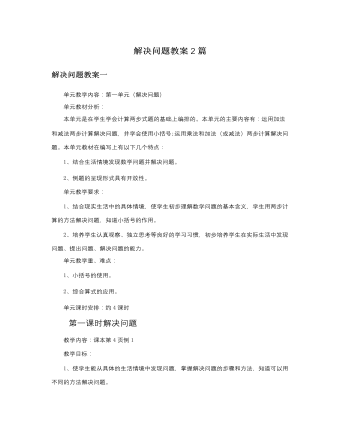
人教版新课标小学数学二年级下册解决问题教案2篇
(1)提问:用自己的话说一说画面的内容。根据画面的内容编一道应用题。可先让学生自由编题,然后出示:面包房一共做了54个面包,第一队小朋友买了8个,第二队小朋友买了22个,现在剩下多少个?(2)全班同学读题后提问:题目的已知条件和问题分别是什么?根据“一共做了54个面包,第一队小朋友买了8个”这两个条件可以求什么?(第一队买后还剩下多少个)怎样列式?【54-8=46(个)】那要求还剩下多少个?又该怎样列式?【46-22=24(个)】谁能列一个综合算式?【54-8-22=24(个)】(列好后,要求学生说出每一步算式的意义)教师:大家想一想还有没有不同的想法?(鼓励学生从不同角度去思考问题)根据“第一队小朋友买了8个,第二队小朋友买了22个”可以求出什么问题?(两队一共买了多少个面包?)可以怎样列式?【8+22=30(个)】那要求还剩下多少个?又该怎样列式?【54-30=24(个)】同桌的同学互相讨论一下:如果写成一个算式,应该怎样列式?
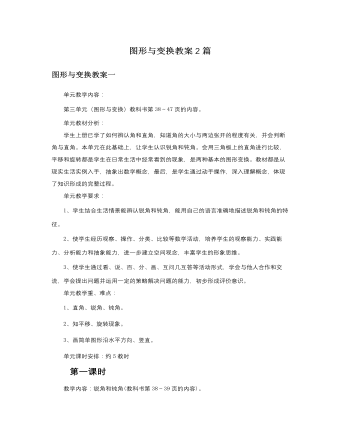
人教版新课标小学数学二年级下册图形与变换教案2篇
第二种分法:分成三类:直角是一类,比直角小的分为一类,比直角的的又分为一类。2.讨论交流,引导学生明确锐角和钝角的意义。教师:比直角小的就是直角的弟弟,比直角的的就是它的哥哥。我们来为它们起个名字好吗?让学生充分交流后引导小结:比直角小的叫锐角,比直角大的叫钝角。相互讨论:怎样判断一个角是不是锐角或钝角?学生讨论(得出和直角比、用眼睛看等方法)三、实践应用,巩固提高1.完成练习九的第1、2题。2.画一画:请你分别画出一个直角、锐角和钝角。四、游戏活动1.折一折,比一比。让学生利用身边的材料折出不同的角,并互相认一认是什么角?2.摸摸、猜猜。(分小组活动)活动规则:把一同学眼睛蒙住,另一同学用活动角掰成大小不同的角,让蒙住眼睛的同学通过手摸后说出是什么角?其他同学当裁判。然后组内同学交换活动。五、全课总结这节课我们学习了什么?你有哪些收获?六、布置作业
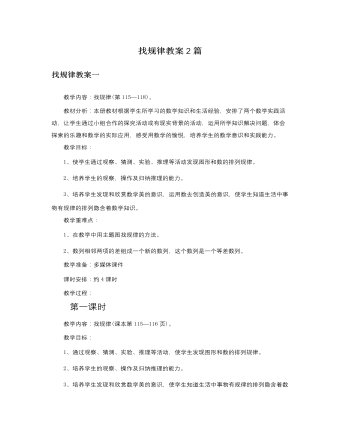
人教版新课标小学数学二年级下册找规律教案2篇
1.动物园里举行运动会,小动物可高兴了,你瞧,他们排着整齐的队伍走出来了。老师分步出示图片,让学生观察,你发现了什么?第一步逐一贴出图片;小熊、兔子、猴子、青蛙;第二步逐一贴出图片:兔子、猴子、青蛙、小熊;第三步逐一贴出图片:猴子、青蛙、小熊、兔子;第四步怎样贴呢,学生试贴:青蛙、小熊、兔子、猴子。教师:为什么这样贴呢?说出你的理由。2.观察整幅方阵图,你们发现了什么?3.请四个学生上台问及此事,做类似方阵图中动物的排列,四位同学不停的变换位置。(体会其中循环排列的含义)教师:深入观察,你们还发现了什么?教师:刚才同学们用自己的语言形容出其中的排列规律;我们可以说这种排列方式是循环排列的规律。4.小东家搞装修,房子是怎样布置的呢?我们一起参观参观,有什么规律呢?学生讨论讲解:墙面与地面都是循环排列的规律。
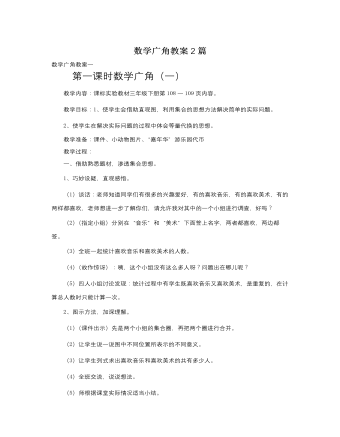
人教版新课标小学数学三年级下册数学广角教案2篇
1、同学们都听说过“曹冲称象”的故事吧!曹冲是怎么称出大象的重量的呢?让我们一起来回顾这一过程。2、曹冲是把大象的重量转换成了什么的重量呢?【他是把大象的重量转换成了与它重量相等的石头的重量】因为当时没有那么大的称能直接称出大象的重量,所以曹冲就用石头的重量代换了大象的重量,称出了石头的重量也就知道了大象的重量。3、同学们,你们大概还不知道吧,曹冲确实非常了不起,他运用了一种重要的数学思考方法——等量代换。【板书:数学广角——等量代换】这节课我们就来学习如何用“等量代换”的方法解决问题。二、引导探究发现规律1、今天这节课,老师给同学们带来了神秘的礼物。猜猜,什么样的孩子能够得到它们?全班?个大组,哪组的成员在参与过程中积极主动,认真动脑思考,遵章守纪,老师就奖励这个组一个青苹果,三个青苹果可以换一个红苹果,两个红苹果可以换取一份神秘的礼物。看看哪个组能得到礼物。有信心吗?老师相信你们是最棒的。
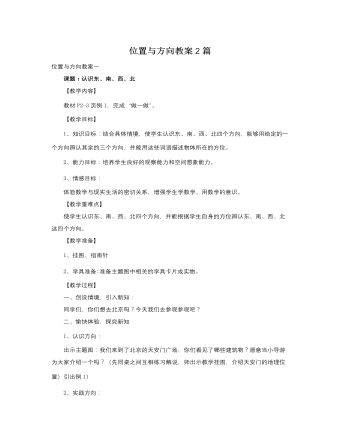
人教版新课标小学数学三年级下册位置与方向教案2篇
【教学目标】1、知识目标:结合具体情境,使学生认识东、南、西、北四个方向,能够用给定的一个方向辨认其余的三个方向,并能用这些词语描述物体所在的方位。2、能力目标:培养学生良好的观察能力和空间想象能力。3、情感目标:体验数学与现实生活的密切关系,增强学生学数学、用数学的意识。【教学重难点】使学生认识东、南、西、北四个方向,并能根据学生自身的方位辨认东、南、西、北这四个方向。【教学准备】1、挂图、指南针2、学具准备:准备主题图中相关的学具卡片或实物。【教学过程】一、创设情境,引入新知:同学们,你们想去北京吗?今天我们去参观参观吧?二、愉快体验,探究新知1、认识方向:出示主题图:我们来到了北京的天安门广场,你们看见了哪些建筑物?愿意当小导游为大家介绍一个吗?(先同桌之间互相练习解说,师出示教学挂图,介绍天安门的地理位置)引出例1)
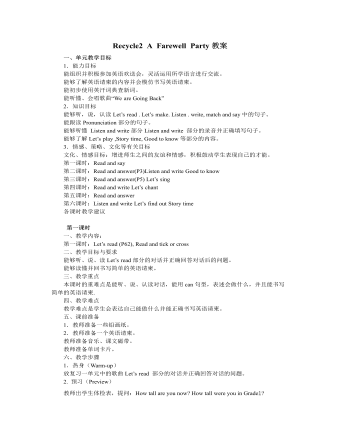
人教版新课标PEP小学英语六年级下册Recycle2 A Farewell Party教案
3. 新课呈现(Presentation) Let’s make (1)教师说:Miss White is making a book about her students. So she can remember them well.Who are the students? 请学生独立或分小组朗读四段短文,解释学生不理解的句子,然后说:There are four pictures below. Would you like to help Miss/White glue the pictures? 教师知道学生完成图文搭配的练习。 (2)教师发给每名学生一张铅画纸,说:Now please draw a picture of your best classmate. Then describe him or her.学生画一副最要好的同学的肖像,并在傍边配上对该同学的英语介绍。 学生上讲台介绍自己最要好的同学,请其他学生猜是谁,看谁说的生动又贴切,教师给予评价时注意强调第三人称单数形式的使用。 Story time 教师向学生展示Story time部分的教学挂图,指着最后一副图中的Zoom 和 Zip说 Look at the picture. Zoom and Zip are sad. They are saying goodbye to each other. Now let’s see What happened. 学生同桌之间合作阅读或是,然后教师提出问题Where is Zip going? Is this good news for zoom ? What grade is Zip going to be in? 教师放录音,学生录音跟读故事,然后再分角色朗读.

人教版新目标初中英语七年级下册I want to be an actor教案2篇
三、教学建议第一课时:1. Lead in (Vocabulary)A) Before class, teacher should collect some pictures of working places. For example: Bank, TV Station, Restaurant, Police Station, Hospital ...B) In class, show students the pictures (PowerPoint, OHP). Ask students to tell the name of the working places and the name of the jobs.Shop assistant, doctor, actor, reporter, police office, waiter, bank clerk, studentC) Do exercise 1a and 3a.2. Bingo GameAsk groups of students to make up pairs of cards with a job on one and the related workplace on the other. For example, waiter / restaurant, teacher / school, doctor / hospital. Encourage students to use both the job / workplace combinations in the book and the ones that students came up during class discussions. Be sure they have twice as many sets of cards as there are students in the group. They can make two sets of cards for a single job / workplace, if necessary. Then have each group mix up its set of cards and hand their cards out in random order. Each time a student gets a pair of cards that match, he or she can lay these cards down. The goal is to have no cards in your hand at the end.3. Task OneA) Ask students to work in pairs and ask the partner what does he / she want to be in the future.e. g. :What do you / does he / does she want to be?I want to be a.Why?Because it's (adj).B) Vocabulary: Section B, 1a4. Homework 1.2.

人教版新目标初中英语七年级下册Why do you like koalas教案2篇
单元整体说明(一)单元教材分析本单元的核心话题是描述动物和表达个人喜好,以及句式why do you like…? Because…。这也是本单元的教学重点。通过本单元的学习,学生应能较流利地运用所学词汇和句型描述动物,表达个人喜好。(二)单元知识结构1.词汇动物名称 tiger, elephant, koala, dolphin, etc.词汇描述性形容词: smart, cute, ugly, clever, shy, etc.国家名: Australia, South Africa2.句型Why do you like koala hears? Because they are cute.Where are pandas from? They're from China.What animals do you like? I like dolphins.(三)单元整体目标1.Master the vocabulary2.Master and use: Why do you like koalas? Because they am cute.Where are pandas from? They're from China.What animals do you like? I like dolphins.(四)单元教学重难点一览(五)单元学情分析学生此前已经学过由why, where, what 引导的特殊疑问句句型,具有了学习本单元知识的认知前提。形形色色的动物能激发学生的好奇心,产生了解它们的欲望,这有利于本单元知识的教学和学生学习兴趣的培养。

人教版新目标初中英语八年级下册If you go to the party, you’ll have a great time教案2篇
区分宾语从句、定于从句和状语从句宾语从句和状语从句,都叫做主从复合句。宾语从句主要是中考必考的,是初中阶段必掌握的从句,宾语从句主要是掌握三要素,所谓宾语从句,就是宾语在主从复合句当中充当宾语的一个句子,叫做宾语从句。主句的谓语动词是及物动词,后面如果是词或者是短语的话,是简单句,如果是句子的话,肯定是宾语从句。I know that he good at English.就是宾语从句,三要素,一要素是要注意连词,连词一共学了三类连词,一类连词是that口语当中可以省略,就像刚才说的那一句,I hear he is good at English.还有疑问代词、疑问副词,how where when,疑问代词、疑问副词。还有一类连词weather是否的意思,不是状语从句当中的如果,这一定要和如果区分开,这是是否。I don't know if he interested at English。宾语从句要注意if是连词。第二要素是语序,要用陈述举语序。比如说你家有几口人,我们都说How many people are there in you family?但是这是简单句,一旦说成宾语从句,你可以告诉我你家有几口人吗?Could you tell me how many people there are in you family ?

人教版新目标初中英语八年级下册It’s a nice day, isn’t it教案2篇
"Hello! Welcome to English class! Introduce yourself. Meet your new classmates." That's what the teacher says. What do you say? "Oh no!" It can be difficult talking to new people. But it can be fun, and you can make friends. How do you do it? Make small talk. Small talk is polite conversation. "Wang Nan is a great pingpang player, isn't she?" "I'd love to meet her, wouldn't you?" "It's been raining a lot, hasn't it?" Tag questions are a form of polite speech. To make small talk successfully, you should know how to make them. You should also know what topics to talk about. Try to learn this unit carefully. The next time you're in English class, you'll find out. Making small talk's easy, isn't it? (“你好!欢迎你!请做一下自我介绍。认识一下你的新同学。”通常在课上老师会这样说。你会说什么呢?“噢,不!”与陌生人谈话太困难了。但是这也很有意思,并且你还能交到朋友。你该怎么做呢?闲聊。闲聊指得是礼貌的对话。“王楠是一个很棒的乒乓球运动员,不是吗?”“我希望自己能认识她,你呢?“今年的雨水很多,不是吗?”反意疑问句是一种礼貌用语。为了使得谈话成功,你应该知道怎样去进行闲聊。你还应该知道与不同的人该谈论什么样的话题。认真的学习这个单元吧,下次在英语课上,你会发现与大家展开谈话是一件很容易的事情,不信我们来试试。)

人教版新目标初中英语八年级下册He said I was hard-working教案2篇
This activity introduces some new vocabulary and provide oral practice using the target language.Task 1 . Ask four students to stand in front of the class, and the teacher asks them the following questions as a reporter.1.What are you going to do when you grow up?2.What are you going to do next week?3.What are going to do after school?The students will give different answers, then ask a good student to report what they said.I am going to e a doctor.What did she say?----------She said she was going to be a doctor.I am going to have a party on Friday night.What did he say?-------He said he was going to have a party on Friday night.I am going to do my homework.What did she say ?------ She said she was going to do her homework.I am going home after school.What did she say?-----She said she was going home after school.Say In this unit we are going to learn to use words like to report what someone said.Task 2. Read the instructions. Then ask a student to read the four questions. And write the words on the Bb. Explain what soap opera is.Task 3. Ask the students to Look at the pictures, point out the TV screens in the picture. Ask one girl to read what Marcia said.What did Marcia say? She said She said she was having a surprise party for Lana on Friday night. Repeat the other pictures in the same way.Activity3. Listen and number the pictures in activity 1a.

人教版新目标初中英语八年级下册Would you mind turning down the music教案
Step 4. Group work (4)1. Ask a pair of students to read the dialogue. Say, This activity provides speaking, listening and writing practice using the target language.2. Ask students to complete the work in groups.3. Check the answers with the whole class. 4. Explain some of the language points. Step 5. Word review (Self check 1)1. Ask students to read the words and the phrases given. 2. Fill in the blanks with proper forms of these words to complete the sentences. 3. Check the answers with the whole class. Homework:Do activity 2 on page 57 after class. Period 6Teaching aims: 1. Teach vocabulary words and the useful expressions. 2. Enable the students to learn etiquette in different culture. 3. Help the students learn how to behave politely in public places and in daily life. Teaching procedures:Step 1. RevisionHelp students to review the function of making requests through a free talk. Then lead them to the topic of etiquette. Explain the meaning of etiquette. Or, ask students to look it up in the dictionary. Step 2. Pre-reading (Section 1)1. Ask students to read the picture and make a list with their partner about how many rules of etiquette can be seen being broken.

人教版新目标初中英语九年级下册Could you please tell me where the restrooms are教案
Step Ⅰ RevisionCheck homework. Ask a few students to read the article in 3a.Then ask a few students to read their guides.Step Ⅱ Part 1Look at the words in the box. Ask a student to read them. Make sure the students understand the meaning of the words. You are to fill in the blanks with the words. In some cases, students may need to use another form of the word, for example adjusting for tense or subject/ verb agreement.Ask students to fill in the blanks on their own.Check the answers. Step ⅢPart 2Go through the instructions with the class.Look at the example with the students.Ask students what the answer would be.Ask a student to read the question and answer it.Excuse me, could you tell me where the bank is, please?The bank is across the street from the shopping malt.Get students to complete the work in pairs.Check the answers. Ask a few students to read their questions.Step Ⅳ Just for Fun!Ask all the students to read the conversation. Ask: What is funny about this cartoon? Help students to explain. A Martian is a person from the planet Mars.There is no such thing as Martian food on Earth, and the clerk looks silly because he is trying to think of where there is a Martian restaurant.Invite some pairs of students to present this conversation to the rest of the class.Step Ⅴ Summary and HomeworkIn this class, we’ve done much writing practice using the key vocabulary words and the target language presented in this unit. After class, please finish the questions in 2 in your exercise books. Then finish the exercises on pages 47~48 of the workbook as well.The Seventh Period Ⅰ Teaching Aims and Demands1. Knowledge Objects(1) Key Vocabularyimage, adventure, jealousy, hero, crime, journey, brave, no longer, show interest in, take it easy, become interested in, plain looks(2)Text:Grown-ups like cartoons, too.2. Ability Objects(1) Fast-reading to get a general idea of the text.(2) Careful-reading to get the detailed information in the text.

人教版新目标初中英语九年级下册I’ll help clean up the city parks教案
Talk about offering help (P60)I’ll help clean up the city parks.A: I’d like to work ...B: You could help ...Talk about ways to tell people about the Clean-Up Day (P61)We need to ...We can’t ...I’ll ...Talk about the work the volunteers do (P62)These three students all volunteer their time to help other people.Somebody loves to ... / helps ... / plans to ... / wants to ...A: What do you like doing?B: I like ... A: What kind of volunteer work do you think I could do?B: You could ...1. 重点词汇advertisement, fix, repair, pleasure, blind, deaf, shut, carry, specially, fetch2. 认读词汇hunger, homeless, cheer, clean-up, sign, establish, major, commitment, elementary, veterinarian, coach, similar, call-in, strategy, disabled, organization, unable, support, appreciate, donation, part of speech, pronoun, adverb, preposition, conjunction, donate, Jimmy, Sally3. 词组clean up, cheer up, give out, put off, set up, think up, take after, fix up, give away, put up, hand out, work out, at once
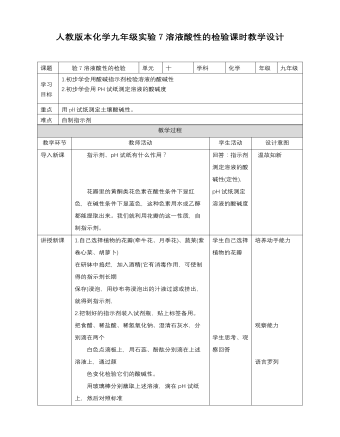
初中化学人教版九年级下册《实验活动7溶液酸碱性的检验》教案
1.自己选择植物的花瓣(牵牛花、月季花)、蔬菜(紫卷心菜、胡萝卜) 在研钵中捣烂,加入酒精(它有消毒作用,可使制得的指示剂长期 保存)浸泡,用纱布将浸泡出的汁液过滤或挤出,就得到指示剂, 2.把制好的指示剂装入试剂瓶,贴上标签备用。 把食醋、稀盐酸、稀氢氧化钠、澄清石灰水,分别滴在两个 白色点滴板上,用石蕊、酚酞分别滴在上述溶液上,通过颜 色变化检验它们的酸碱性。 用玻璃棒分别蘸取上述溶液,滴在pH试纸上,然后对照标准 比色卡比较,得出pH值,也就是酸碱度。 把上述溶液滴在白色点滴板上,用滴管吸一下你自制的指示剂,滴在滴板的溶液里,观察颜色变化,每用一种指示剂,换一下滴板的溶液。 把所得到颜色变色变化的信息和pH值数据填入教材第70页的表中。 3.取少量土壤样品,将土壤样品与蒸馏水按1∶5的质量比在烧杯中混合, 充分搅拌后静置,用玻璃棒蘸澄清的液体,滴在pH试纸上,然后对照 标准比色卡记录读数。
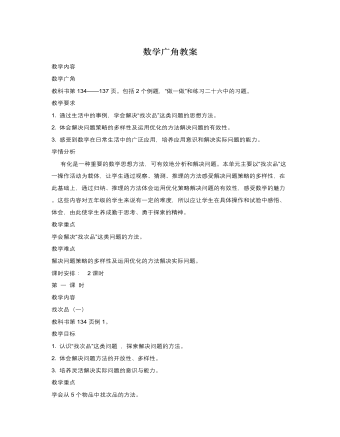
人教版新课标小学数学五年级下册数学广角教案
教学要求1. 通过生活中的事例,学会解决“找次品”这类问题的思想方法。2. 体会解决问题策略的多样性及运用优化的方法解决问题的有效性。3. 感受到数学在日常生活中的广泛应用,培养应用意识和解决实际问题的能力。学情分析有化是一种重要的数学思想方法,可有效地分析和解决问题。本单元主要以“找次品”这一操作活动为载体,让学生通过观察、猜测、推理的方法感受解决问题策略的多样性,在此基础上,通过归纳、推理的方法体会运用优化策略解决问题的有效性,感受数学的魅力。这些内容对五年级的学生来说有一定的难度,所以应让学生在具体操作和试验中感悟、体会,由此使学生养成勤于思考、勇于探索的精神。教学重点学会解决“找次品”这类问题的方法。
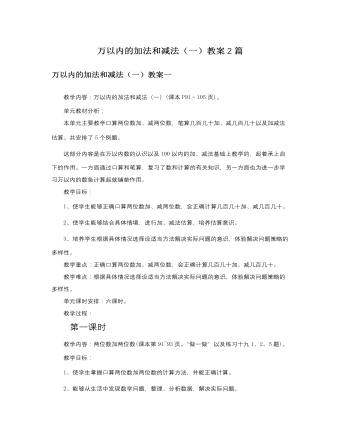
人教版新课标小学数学二年级下册万以内的加法和减法(一)教案2篇
3.小结。引导学生归纳两位数加减法的口算步骤:要把加上或减去的两位数看成一个整十数和一个一位数,先算两位数加、减整十数,再算两位数加减一位数。三、巩固练习课本第93页的做一做。分别指名口算,并说说怎么想的。四、全课总结1.根据学生回答,教师归纳小结并出示课题:口算两位数加、减两位数。2.口算两位数加、减两位数应注意什么?五、布置作业教后反思《标准》提倡算法多样化,目的是提倡学生个性化的学习。本单元仍然注意体现这一理念,如本课时教学口算两位数加、减两位数时,既呈现了口算方法,还出现了在脑中想竖式的方法;在教学笔算时,还出现口算的方法。其目的就是鼓励学生展开思路,在交流、比较的基础上不断地完善自己的想法,学习计算方法。
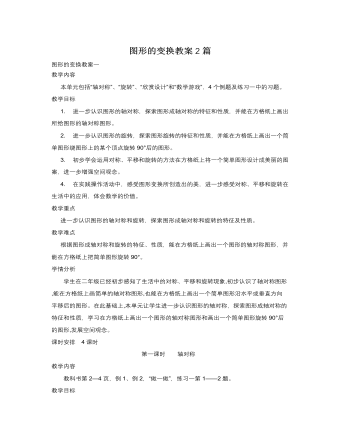
人教版新课标小学数学五年级下册图形的变换教案2篇
师:从图1到图2,风车发生了怎样的变化呢?下面请同学们小组合作,共同来解决报告单上提出的问题。(1)从图1到图2,风车绕点O逆时针旋转了___度。(2)你是怎样判断风车旋转的角度的?生小组讨论。3.小组汇报(实物投影展示)(1)图1到图2,风车绕点O逆时针旋转了90°;(2)组1,根据三角形变换的位置判断风车旋转的角度;(3)组2,根据对应的线段判断风车旋转的角度;(4)组3,根据对应的点判断风车旋转的角度。4.小结(教师边做小结边演示)师:通过观察,我们发现风车旋转后,不仅是每个三角形都绕点O逆时针旋转了90°(闪烁),而且,每条线段(闪烁),每个顶点(闪烁),都绕点O逆时针旋转了90°。5.揭示旋转的特征和性质